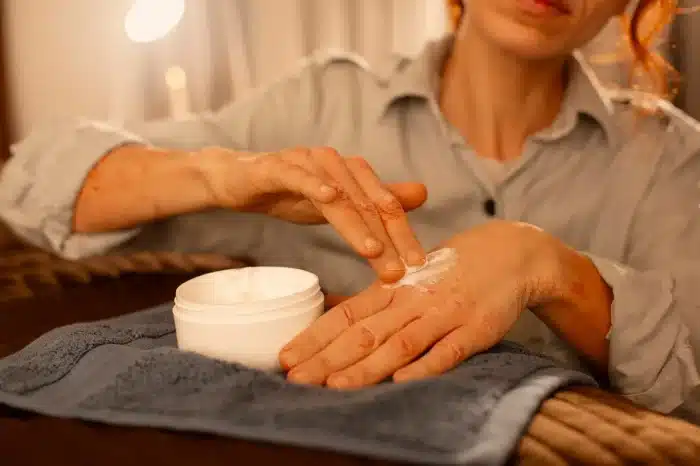
A study found that the effectiveness and safety of topical anesthetics like lidocaine/prilocaine are highly dose-dependent. Optimal results are typically achieved with 1–2 grams per 10 cm² of skin. However, this range may vary depending on the type of procedure, such as minor venipuncture versus more extensive dermal interventions.
EMLA cream, containing a 1:1 ratio of lidocaine and prilocaine, is designed to deliver this balance safely. It’s commonly used in clinical and cosmetic procedures for localized skin anesthesia with minimal discomfort. Recommended application times vary by location, but regardless of the site, occlusive dressings play a key role in enhancing absorption and anesthetic depth, especially for longer or deeper procedures.
This article will explore the recommended dosage for EMLA cream, timing strategies, and application best practices to ensure safe and effective use across different clinical contexts.
Key Takeaways
- For most procedures, apply 1–2 grams per 10 cm² of skin, adjusted according to procedure type and patient needs.
- Leave EMLA on for at least 1 hour for minor procedures and up to 2 hours for more extensive treatments. Shorter times may be effective for mucosal applications.
- Always cover the cream with an airtight dressing to enhance absorption and improve anesthetic effect.
- Follow age-specific dosing for pediatric patients and use caution in individuals with G6PD deficiency due to methemoglobinemia risk.
- Excessive use or prolonged exposure increases the risk of systemic toxicity—especially in infants or those with blood disorders.
About: Doctor Medica is your trusted supplier of top-quality dermal fillers, viscosupplements, and more for your medical practice. We offer genuine products from leading brands at the lowest prices. Contact the Doctor Medica today to order EMLA Cream online for your practice.
Factors Influencing Optimal Dosage
Several factors determine the appropriate EMLA cream dosage, and tailoring it to individual needs ensures both safety and effectiveness:
- Procedure Type: Minor dermatologic procedures typically require less cream and shorter application times compared to more invasive interventions like laser resurfacing or ulcer debridement.
- Application Area: Larger or thicker-skinned areas demand higher doses for effective anesthesia.
- Patient Age and Weight: Pediatric and adult patients differ in skin permeability and body surface area, influencing how much cream is safe and effective.
- Skin Condition: Intact skin allows for predictable absorption, while irritated or damaged skin may absorb more rapidly—requiring careful dosage adjustment.
By accounting for these factors, healthcare providers can customize the dosage to achieve reliable anesthesia while minimizing potential risks.
Evidence-Based Dosage Guidelines and Recommendations
Clinical practice guidelines support the following general recommendations:
- Minor Dermatologic Procedures: Apply ~1 g per 10 cm² and cover with an occlusive dressing for at least 1 hour.
- Major Dermatologic Procedures: Use up to 2 g per 10 cm², left under occlusion for 2 hours.
- Leg Ulcers (Debridement): Apply 1–2 g per 10 cm², not exceeding 10 g, for 30–60 minutes.
- Genital Mucous Membranes: Apply 5–10 g without occlusion for 5–10 minutes before minor procedures like excisions or cryotherapy.
These dosage guidelines ensure adequate anesthesia while supporting patient comfort and safety during various types of interventions.
Dosage Considerations for Specific Patient Populations
EMLA cream requires dose adjustments for vulnerable groups:
- Pediatric Patients:
- 0–3 months (<5 kg): Max 1 g over 10 cm² for ≤1 hour.
- 3–12 months (>5 kg): Max 2 g over 20 cm² for ≤4 hours.
- 1–6 years (>10 kg): Max 10 g over 100 cm² for ≤4 hours.
- 7–12 years (≥20 kg): Max 20 g over 200 cm² for ≤4 hours.
- Geriatric Patients: Generally no dose adjustment needed, but monitor for skin fragility or slower metabolism.
- Patients with Methemoglobinemia Risk: Prilocaine can elevate methemoglobin levels and reduce oxygen delivery in individuals with G6PD deficiency.
Application Thickness and Duration Guidelines

To ensure maximum anesthetic benefit:
- Thickness: Apply a thick, visible layer without rubbing it in. This allows for uniform absorption into the dermal layer.
- Occlusion: Always apply an occlusive dressing (e.g., Tegaderm or plastic wrap) to enhance penetration and prevent premature drying.
- Duration:
- Minor procedures: At least 1 hour.
- Extensive treatments: 2 hours or longer, as needed.
- Genital mucosa: 5–10 minutes without occlusion is usually sufficient.
Proper timing is crucial to ensure peak numbing before the procedure begins.
Practical Application and Safety Measures

Safe usage of EMLA cream hinges on adherence to dosing limits and application protocols:
- Avoid Overuse: Excessive amounts or prolonged application may lead to systemic toxicity, especially in infants and those with blood disorders.
- Monitor for Adverse Effects: Watch for redness, pallor, or signs of methemoglobinemia, such as fatigue or bluish skin.
- Storage: Store at room temperature, away from heat or light. Do not refrigerate.
- Patient Counseling: Clarify when and how to apply, especially when discussing EMLA ingredients, to ensure safe usage and prevent allergic reactions.
Healthcare professionals should always assess individual risk factors before recommending off-label or high-dose applications.
Conclusion
Understanding appropriate EMLA cream dosage is essential for delivering safe and effective localized anesthesia in both clinical and cosmetic settings. By tailoring the dose based on procedure type, patient characteristics, and application site, healthcare providers can ensure optimal results.
Mastery of application technique, duration, and safety precautions allows EMLA to remain a valuable tool for pain-free care.
FAQs
1. What is the recommended EMLA cream dosage for minor skin procedures?
The standard dosage is approximately 1 gram per 10 cm² of skin for minor procedures like needle insertions or small skin biopsies.
2. What happens if too much EMLA cream is applied?
Exceeding the recommended dosage increases the risk of systemic toxicity, particularly methemoglobinemia. Symptoms may include dizziness, fatigue, or bluish skin discoloration. Following proper application guidelines is crucial, and avoid using the cream on broken skin or in large areas.
3. How does application time affect the effectiveness of EMLA cream?
The effectiveness of EMLA cream is directly tied to the dosage and application time. For example, a one-hour application may be sufficient for minor procedures, while larger or deeper interventions may require two hours. Proper timing ensures the anesthetics penetrate the skin fully for optimal numbing.
4. Can EMLA cream be used on broken or irritated skin?
EMLA cream should not be applied to broken or irritated skin unless directed by a healthcare provider, as it may increase absorption and the risk of adverse effects.
5. What are the common side effects of EMLA cream?
Common side effects include mild redness, itching, or burning at the application site. Rarely, it may cause allergic reactions or methemoglobinemia.
6. How long does the numbing effect last after application?
The numbing effect typically lasts 1–2 hours after the cream is removed.
7. Is EMLA cream safe for use during pregnancy or breastfeeding?
EMLA cream is generally considered safe during pregnancy and breastfeeding when used as directed, but consult a healthcare provider for specific advice.
References
Lee HS. Recent advances in topical anesthesia. J Dent Anesth Pain Med. 2016;16(4):237-244. doi:10.17245/jdapm.2016.16.4.237
emc. EMLA Cream 5% (5g pack) – Patient Information Leaflet (PIL). https://www.medicines.org.uk/emc/product/871/pil
EMLA Dosage Guide. Drugs.com. https://www.drugs.com/dosage/emla.html
Related Articles
Joanna Carr
Vabysmo Dosing and Treatment Frequency
Learn the recommended Vabysmo dosing and treatment frequency, plus what patients can expect during therapy for retinal conditions.
Joanna Carr
Radiesse Cheekbones – Lift and Sculpt
Clinical data supports the efficacy of Radiesse for cheek enhancement, showcasing long-term results and high patient satisfaction rates.
Joanna Carr
Powerfill Ingredients – PDLLA and Other Ingredients
Learn about Powerfill's ingredients, including PDLLA and other key components, to understand its formulation and benefits for aesthetic treatments.


